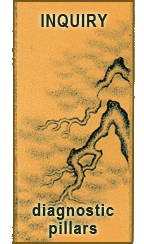Generalities to Guide Clinical Practice (A Quick Guide)

There are certain answers that come up frequently during the “inquiry” phase of the diagnostic interaction in Chinese medicine.
For instance, whenever you see secretions or excretions that are yellow, no matter where they appear, the diagnostic significance always points to heat. The same can be said of clear or white secretions, they indicate cold. That can be speaking of urine, phlegm, or any secretions, even ejaculate. (I should note that ejaculation *should* be white, but not clear which might indicate a Kidney deficiency such as yang deficiency in which case we could say this indication suggests internal cold of the deficiency type.)
As is the case with all of Chinese medicine diagnostics, these findings need to be triangulated (quadrangulated?) with the three other pillars of diagnosis, namely palpation (including pulse diagnosis), observation (including tongue diagnosis), and “listening/smelling”.
These generalities can easily guide a practitioner toward relevant, accurate, and efficacious diagnosis. Enjoy.
| GLOBAL GENERALITIES | |
|---|---|
| Discharges | |
| Clear and copious | cold |
| Yellow and scanty | heat |
| Cloudy | damp |
| Pus | toxicity |
| Yellow to green | heat |
| Thin and watery | phlegm damp |
| Hard and difficult to expectorate | dry phlegm |
| Pale pink, red, or purple urine | bleeding |
| Sounds | |
| Loud | excess |
| Soft | deficiency |
| Aggravation | |
| worse with rest | stagnation |
| worse with fatigue | deficiency |
| worse with heat | heat |
| worse with cold | cold |
| worse with damp weather | damp in the channels |
| worse with pressure | excess |
| increases by eating | excess |
| after sex | kidney deficiency |
| with stress | Liver Qi stagnation |
| before period | Liver Qi stagnation |
| after period | Blood deficiency |
| Amelioration | |
| better with rest | deficiency |
| better with movement | stagnation |
| better with heat | cold |
| better with cold | heat |
| better with pressure | deficiency |
| diminishes with eating | deficiency |
| Appearances | |
| Red | heat |
| Pale and flaccid | deficiency |
| Pink or pale red | yin deficiency |
| Nodular or lumpy | stagnation of Qi, Blood, or phlegm (or combination of the three) |
| Red with pus | heat with toxicity |
| Pain | |
| pain migrates | Wind in the channels |
| red, swollen, hot joints | heat in the channels |
| dull, distended, larger area | qi stagnation |
| sharp, fixed, smaller area | blood stagnation |
| heavy pain | damp |
| cramping pain | cold |
| burning pain | heat |
| Onset | |
| Acute onset, short duration | exterior |
| Slow onset, chronic duration | interior |
| excess pathologies tend to run their course quickly and are more intense. | |
| deficiency pathologies tend to run chronically and are low-grade. | |
| Times ‘O The Day | |
| Dawn | shao yang |
| Midday | tai yang |
| Afternoon to dusk | yang ming |
| Dusk to midnight | shao yin |
| Midnight to 3 am | tai yin |
| 3 am to dawn | jue yin |
| Age | |
| elderly | tend to suffer from deficiencies |
| youth | tend to suffer from excesses |
| children | can be excessive or deficient |
| Liver Signs | |
| Pathologies that are coincidental to the period | generally indicate a Liver involvement. |
| Pathologies that are stress induced | generally indicate a Liver involvement. |
| Gender Specific Issues | |
| Women tend to suffer from a deficiency of Blood (through menopause, then Yin) | |
| Men tend to suffer from a deficiency of Yin or Yang or Jing | |
| Food and Drink | |
| desire for warm | cold |
| desire for cold | warm |
| Areas of Domination | |
| flanks | gall bladder |
| hypochondrium (includes back and front) | Liver |
| lumbus (low back) | Kidney |
| epigastric region (below ribs on midline) | Stomach |
| “alternating” things | Shao Yang (GB) |
| one sided things | Shao Yang (GB) |
| File under “Duh” | |
| cough | Lungs |
| palpitations | Heart |
| diarrhea | Spleen |
 Last modified: September 11, 2009
Last modified: September 11, 2009  Tags: Diagnosis, inquiry, Listening, Observation, Palpation, Smelling, study guide В· Posted in: Inquiry
Tags: Diagnosis, inquiry, Listening, Observation, Palpation, Smelling, study guide В· Posted in: Inquiry
